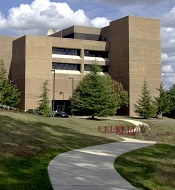
Environmental Factor, August 2007, National Institute of Environmental Health Sciences
Network Approaches Symposium Highlights Systems Biology Research
By Eddy Ball
September 2007

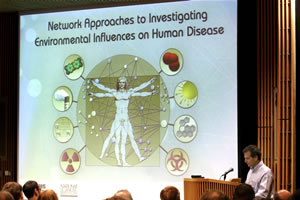
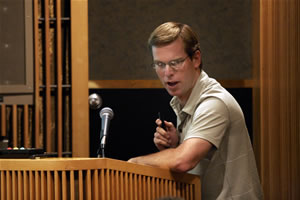
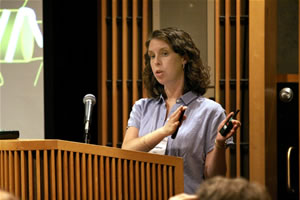
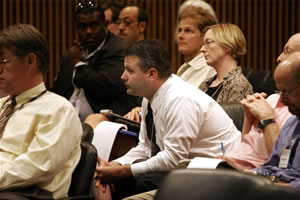
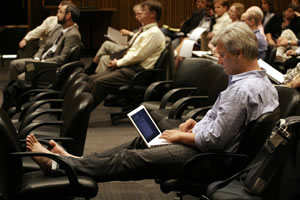
NIEHS and the National Cancer Institute (NCI) co-sponsored a conference on August 16 in Rodbell Auditorium featuring talks by leading figures in the close-knit community of scientists working in basic, conceptual and translational research employing systems biology approaches. Titled "Network Approaches to Investigating Environmental Influences on Human Disease," the meeting was chaired by David Balshaw, Ph.D., program administrator in the Center for Risk and Integrated Sciences, a program in the Division of Extramural Research and Training (DERT).
In his welcoming address to symposium participants, several of whom were NIH grantees, David A. Schwartz, M.D., acknowledged the contributions by people at NIEHS, NCI, the National Heart, Lung and Blood Institute and the National Center for Research Resources. "This symposium will help us identify some approaches that we can take to understand how biological systems can be perturbed by environmental influences," he explained, "and how those perturbed biological systems relate to changes in human biology that lead to the development of disease."
Schwartz urged participants to keep that continuum in mind and help NIH identify "approaches that we can take in terms of programmatic development that will help us link environmental exposures to biological systems." He also stressed that the meeting would be an opportunity for the scientists to learn more about each other’s work and identify future collaboration possibilities and new research directions.
Systems biology integrates many sciences, including biology, chemistry, physics, computation, engineering, mathematics and medicine, in an endeavor to understand the interaction and cross-regulation of biological pathways and characterize complete biological systems. The research involves extensive laboratory measurement, data mining and modeling in an effort to determine how to manipulate biological systems most effectively to treat and prevent disease.
Although the roots of system biology extend much farther back, the approach gained institutional and industrial support only in recent years. The Seattle-based Institute of Systems Biology was founded in 2000, and Harvard University established its first completely new department in over 20 years with the creation of its Department of Systems Biology in 2003. In the years since, system biology approaches have become a part of research by major biotech and drug development companies, and the approach is gaining a foothold in the toxicology testing and regulatory communities.
The Networks symposium was a day-long series of 11 presentations in four sessions:
- Biological Applications of Network Theory, chaired by Ben Van Houten, Ph.D., of DERT, and featuring lectures by University of California at San Diego molecular biotechnology specialist Trey Ideker, Ph. D., and University of Washington computational biochemist Herbert Sauro, Ph.D.
- Defining Connections in Biological Networks, chaired by Daniel Shaughnessy, Ph.D., of DERT, and featuring presentations by Harvard Medical School cancer geneticist Marc Vidal, Ph.D., NIEHS Tenure Track Investigator Karen Adelman, Ph.D., (see related story) and University of California at San Francisco computational biologist Tanja Kortemme, Ph.D.
- Dynamic Networks: Defining Location and Function, chaired by Sally Tinkle, Ph.D., of DERT, and featuring talks by Carnegie Mellon University machine learning developer Ziv Bar-Joseph, Ph.D., Indiana University School of Medicine bioinformatics specialist Keith Dunker, Ph.D., European Molecular Biology Labs protein complexes analyst Ann-Claude Gavin, Ph.D., and University of Albany cancer genomics investigator Tom Begley, Ph.D., an NIEHS Outstanding New Environmental Health Scientist (ONES) award winner.
- Integration of Biological Networks and Phenotypic Endpoints, chaired by Richard Pelroy, Ph.D., of NCI, and featuring lectures by Massachusetts Institute of Technology biological engineering developer Mike Yaffe. M.D., Ph.D., and Stanford University pediatrician and bioinformatics specialist Atul Butte, M.D., Ph.D.
Systems biology has made significant advances in the past ten to fifteen years, but it faces challenges in achieving the ultimate goal of mapping what is called the "human interactome" — the nearly two million molecular interactions in the human organism. In his 2006 argument in The Scientist for creation of a Human Interactome Mapping Project, at a projected cost of some $100 million, symposium participant Marc Vidal observed that only 1% of the human interactome had been mapped and perhaps only 10% for the model organisms, yeast, worm and the fly.
"Advisory Panel Weighs..." - previous story ![]()
![]() next story - "Endocrinologist Lectures..."
next story - "Endocrinologist Lectures..."
September 2007 Cover Page
